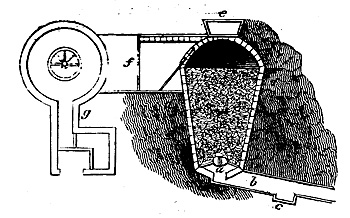How
to Build an Ice House
from Charles McIntosh, The Practical
Gardener, 1828
Keeping
food and drink cool was a perennial problem for householders before
the age of refrigeration. Large houses and estates often had icehouses,
great structures built into the side of a hill or embankment or
even atop a hill and filled each winter with ice from a pond or
lake, ice imported from the highlands, or with snow that, compacted,
would form ice. Maintained well, ice could last the year through
in these ice houses. These instructions date from 1828.
If you already
have an icehouse, then December is the season in which to expect
materials to fill the ice house. Have it properly cleaned out
of all straw, or other filth, that may have accumulated in it.
Have beater and rammers prepared for packing it, when either
snow or ice is found in sufficient quantity to fill it. If the
ice house is built properly, then either snow or ice will suffice.
Ice,
in the hot days of summer, is considered such a luxury that
few that can command it like to be without it. The situation
for an ice house should be chosen on a dry and somewhat elevated
spot of gravelly or chalky ground, and as near to a pond or
piece of water as circumstances will admit of. If the situation
be shaded by more elevated ground, so much the better, but if
it be not naturally so, is may be rendered artificially so by
planting. It must be, as much as possible, hidden from the sun's
rays.
The
form of our ice houses is generally an inverted cone. The London
confectioners, as well as most people on the continent, content
themselves with keeping it in cellars, surrounded with very
thick walls, and without windows, being entered sometimes by
straight and sometimes by crooked passages, secured by double
and often treble doors, and the ice thickly covered by straw
or mats.
The
accompanying figure will give an idea of the general plan of
ice houses in this country.
In
building an ice house, a space of two feet or more should
be left at the bottom (a) for receiving any moisture which
may drain from the ice in the process of melting. From
this space a drain of brickwork (b), set in cement (but
which need not be as large as that in the diagram), carries
the moisture to a considerable distance. This drain should
have a stop or trap for the exclusion of air (c) and over
the space at the bottom (a) should be placed a strong
grating of wood, to let the moisture fall down, which
may at any time proceed from the melting of the ice. The
sides of the well must be walled up with brick or stone,
at least two feet thick, or the wall may be built hollow.
|

|
When
the proper height is obtained, the well may be arched over with
two arches, with a vacuity inbetween, and leaving in the centre
a hole, for the admission of ice (e), and in the sides a door
for taking it out (f). This door, the better to exclude air,
should open into a porch (g) with the three other doors, the
spaces between which should be filled with straw to exclude
more effectively the heat of the atmosphere.
The
whole being covered first with a covering of tempered clay,
and next with a hill of earth. The appearance will not be disagreeable,
and may be covered with evergreens.
The
exterior may also be decorated, as to become an object of ornament,
should it be placed in any part of the dressed grounds.
The
size of the house must depend on the quantity of ice which is
wanted, but we would recommend to make it rather too large than
too small, as it sometimes happens that neither ice nor snow
can be procured to fill it. Sometimes London's confectioners
have had to procure ice from the polar seas. As snow or ice
will keep in a good ice house for two and sometimes three years,
it is advisable to have it large enough, and always to fill
it when opportunity offers, to guard against a casual scarcity.
For an ordinary sized family, a house about ten feet in diameter,
and fifteen deep, will be sufficient. For larger families the
house must be larger, or for small families a well six feet
in diameter, and ten deep, may be sufficient.
Carry
on to How to Fill an Ice House.
Please
also visit Old London Maps
on the web as many of the maps
and views available there have plans and depictions of gardens
from
the medieval period through to the late nineteenth century.
Copyright
© Sara Douglass Enterprises Pty Ltd 2006
No material may be reproduced without permission
unless
specifically stated otherwise
|



